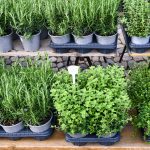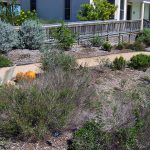Soil should be loose, well-drained, and rich in organic matter and nutrients. But what can you do if yours isn’t?
Healthy soil is the basis of everything in the landscape and garden. But in South Central Texas, soils can be far from ideal.
Fortunately, our Find-a-Plant pages include filters for soil types — if you know your type. Here’s a broad introduction to local soil associations, where they occur, and what it means for your landscape.
If we all had our druthers for growing plants, soil would be loose, well-drained, and rich in organic matter and nutrients with perfectly equal proportions of three basic particles of different sizes: clay, silt and sand.
These “mineral solids” make up 50% of normal soil structure. The rest is composed of air (22%), water (22%) and organic matter like compost and other organisms. If the proportions of mineral solids were equal, then you would have loam — a nearly perfect growing texture with medium-sized particles and large numbers of pores that can hold higher volumes of water in suspension where it’s available to plant roots.
In Bexar County, however, perfect growing textures aren’t widely distributed, and many of our soils are instead typified by high proportions of clay, with coarser sediments like sand (in the south) and rock (in the north).
- Sandy soils are composed of comparatively large grains that lack nutrients and drain very quickly when wet, meaning they retain less water than other textures. In Bexar County they’re not common in heavily developed areas, but loamy sands, sandy loams, sandy clays (and embedded sandstones) sit atop a clay layer from the Medina River south to Atascosa County and northeast from Braunig Lake all the way to St. Hedwig.
Sandy soil is easily identified in the hand, with its gritty, brown-sugar like grains.
- Surface clay (or clay loam) soils are at their deepest in the middle third of the county, extending between riparian creek and river basins from Medina River in the southwest toward Converse in the northeast, and broadly encircled by Loop 410 in the center. In a drought like we’ve experienced this year, “shrink-swell” clay soils can shrink so much they pull back from house skirting and expose cracks and gaps in bare ground. Clay soils are composed of densely packed microscopic particles. They can retain plenty of water, but hold on to it tightly in tiny pores, making it harder for water to enter and exit the soil and harder for plant roots to access it. You can recognize clay by its compacted thick and sometimes sticky texture: it can be slippery after rain, but has to be broken off of your shoes with a hammer when dry.
One way to minimize this is to add ¼ to ½ inch of compost twice a year over a four- to five-year period; for the heaviest clay, you can also incorporate ½ to 1 inch of expanded shale. Do not add sand.
- Thin soils in Bexar County underlie some of the fastest-growing portions of the San Antonio area to the north and west, especially outside of Loop 1604. Whatever the texture, they tend to be calcerous, limestone-based and very shallow — less than four inches deep in many areas before you hit solid rock. Although considered “non-arable” when it comes to crops, they’re great for growing native grasses and native plants that are adapted to the shallow soil depth.
Thin soils are easily identified with a shovel: if you can’t dig a test hole deeper than 8 inches before hitting rock, it’s a good sign. Also, you may need a digging bar.
- Well-drained refers specifically to any soil’s water retention capacity. The Find-a-Plant filters on GardenStyleSA recommend it for many plants, including native plants that evolved in shallow Hill Country soils, agaves accustomed to desert conditions, and many other plants like young vegetables and annuals. For these, especially when young, it’s essential to provide good drainage, as their roots can rot in thick clay. Some local soil types (thin and sandy) can be well-drained without any amendments, depending on the site, as can soils on steeply sloping sites or raised beds, especially if filled with potting soils and other bagged soil types composed of peat, sand and perlite.
You can identify well-drained soil by performing a percolation test: dig a 1 foot by 1 foot hole in the ground and fill it with water to see how much water drains in an hour.
If you find your soil is less than perfect, welcome to the club! You can usually improve it by adding a top dressing of compost (or organic matter) twice per year.
What if I don’t know my soil type?
You can use soil maps and soil tests for specific details. But you can also learn a lot about soil just by rubbing it in your hands. Clay soils tend to stick together and they can be shaped and rolled, especially when they’re moist. Loams can be rolled into a ball, but they’ll generally fall apart if poked with a finger. And in sandy soils, of course, individual grains are clearly visible.
To see how your soils stack up on their own, you can perform a fun experiment with non-sudsing dishwater detergent.
When is the best time to apply compost?
Spring and fall. Fall is a terrific time to help refresh garden soil in time for spring. No matter what kind of soil you have, the best way to improve it is by mixing in organic matter such as compost.
Tready lightly.
Your footsteps tend to compact the soil structure, which reduces its ability to conduct water, nutrients and air that plant roots need to thrive. The fastest way to minimize compaction is to core aerate every year and add ¼ to ½ inch of compost. Or, the slower but simpler way is to add the same amount of compost twice a year over a four- to five-year period. Do not add sand. If the soil is heavy clay, then incorporate into the soil ½ to 1 inch of expanded shale. Repeat as necessary.
Add sauce.
Simple sugars like molasses, juices or soda can increase the health of your soil! Microorganisms rapidly feed and reproduce on simple carbon chains, encouraging other organisms to feed and return the nutrients to a form available to plants.




